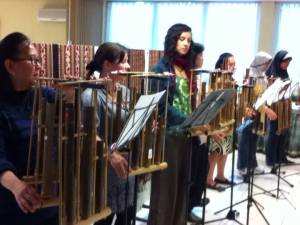At UN, with former Secretary General of UN, Mr. Ban Ki-Moon
Performance at Joglo Semar Event
Performance at AIJ Events

1. Workshop untuk sekolah La Tour, Grand Saconnex, 11 April 2014
2. Pertunjukkan untuk acara sekolahan La Tour, Grand Saconnex, 14 April 2014
3. Pembukaan pameran foto AIJ, di ITU, 9 Mai 2014
4. Ulang tahun UNCTAD, di UN, 17 Juni 2014


thanks to Mas Padi
During Festival of light, thanks to Etty
thanks to Etty
Alunan suara angklung membawakan Lagu Gundul Pacul karya R.C Hardjosubroto berkumandang di ruangan bazaar United Nations Women’s Guild (UNWG) gedung PBB pada tanggal 19 November 2013, menarik perhatian para pengunjung untuk berkumpul di arena panggung baik yang berada di satu lantai, hingga yang menyaksikan dari lantai dua.
Tepukan tangan pun semakin meriah terdengar ketika lagu Heal the World dimainkan oleh group Le Sangkuriang. Sesuai dengan misi bazaar yakni untuk kemanusiaan, lagu ini terasa pas terdengar bahkan beberapa pengunjung ikut bergumam bernyanyi bersama. Selanjutnya irama ceria dari Aux Champe Elysee yang pernah dinyanyikan oleh Joe Dassin, penyanyi Amerika Perancis, terus menghangatkan suasana.
Lagu O solemio menutup penampilan kelompok le sangkuriang siang itu. Tampilnya Le Sangkuriang pada hari itu bertepatan dengan tiga tahun sejak Unesco menetapkan dalam sidangnya di Nairobi, Kenya tanggal 15-19 November 2010 bahwa angklung adalah warisan budaya dunia, Intangible cultural heritage.
Usai tampil di acara Bazaar UNWG, rencana selanjutnya adalah tampil di sekolah Internasional dan WHO di bulan Desember 2013. Dengan adanya kegiatan-kegiatan tersebut diharapkan masyarakat Internasional dapat mengenal dan mengapresiasi budaya angklung.
Angklung is a musical instrument made out of two bamboo tubes attached to a bamboo frame. The tubes are carved so that they have a resonant pitch when struck. The two tubes are tuned to octaves. The base of the frame is held with one hand while the other hand shakes the instrument rapidly from side to side. This causes a rapidly repeating note to sound. Thus each of three or more angklung performers in an ensemble will play just one note and together complete melodies are produced. Angklung is popular throughout Southeast Asia, but originated from Indonesia (used and played by the Sundanese since the ancient times). Since 19 November 2010, Angklung has been declared as Indonesian Intangible Cultural Heritage by Unesco.
Each Angklung consist of 3 parts:
Not all bamboo can be used for angklung instrument, it is selected by its age – has to be at least 4 years old and not more than 6 years old. It is cut on the dry season, between 9 am in the morning to 3 pm at the afternoon. After being cut at its base for about 2-3 span of the hand, it will be stored for about 1 week, so that the bamboo will contain less water. After a week, the bamboo will be cut into certain various sizes. Then, will be stored for about one year to keep it from termites. Some of the other procedures are: by sinking the bamboo beneath mud field, pool or river, also by smoking it at the fireplace, and the modern procedure: by using a certain liquid chemistry formula.
History
The Angklung got more international attention when Daeng Soetigna, from Bandung, West Java, expanded the angklung notations not only to play traditional pélog or sléndro scales, but also diatonic scale in 1938. Since then, angklung is often played together with other western music instruments in an orchestra. One of the first well-known performances of angklung in an orchestra was during the Bandung Conference in 1955. A few years later, Udjo Ngalagena, a student of Daeng Soetigna, opened his “Saung Angklung” (House of Angklung – http://www.angklung-udjo.co.id) in 1966 as centre of its development.
In Hindu period and Padjajaran kingdom era, Sundanese people used the angklung to sign the time for prayer. Later, Padjajaran kingdom use this instrument as corps music in Bubat War (Perang Bubat).
Angklung functioned as building the peoples community spirit. It was still used by the Sundanese until the colonial era (Dutch East Indies, V.O.C). Because of the colonial times, the Dutch East Indies government tried to forbid people playing the angklung instrument.
Outside Indonesia
In the early 20th century, the angklung was adopted in Thailand, where it is called angkalung (อังกะลุง). The Thai angklung are typically tuned in the Thai tuning system of seven equidistant steps per octave, and each angklung has three bamboo tubes tuned in three separate octaves rather than two, as is typical in Indonesia.
Angklung had also been adopted by its Austronesian neighbours, in particularly Malaysia and the Philippines, where they are rather played as part of bamboo xylophone orchestras. Formally introduced into Malaysia sometime after the end of confrontation, it found immediate popularity [. They are generally played using a pentatonic scale similar to the Indonesian slendro, although in the Philippines, sets also come in the diatric and minor scales used to perform various Spanish-influenced folk music.
At least one Sundanese angklung buncis ensemble exists in the United States. Angklung Buncis Sukahejo is an ensemble at The Evergreen State College, and includes eighteen double rattles (nine tuned pairs) and four dog-dog drums.